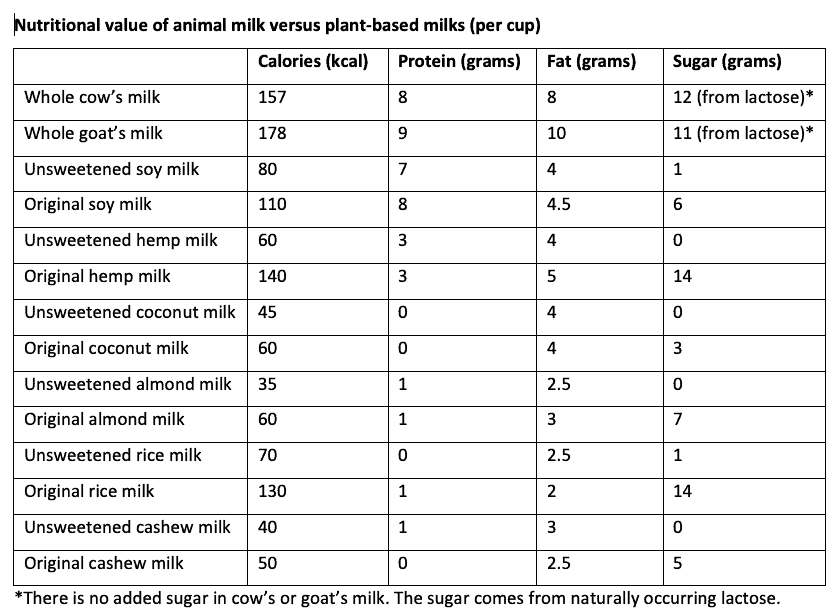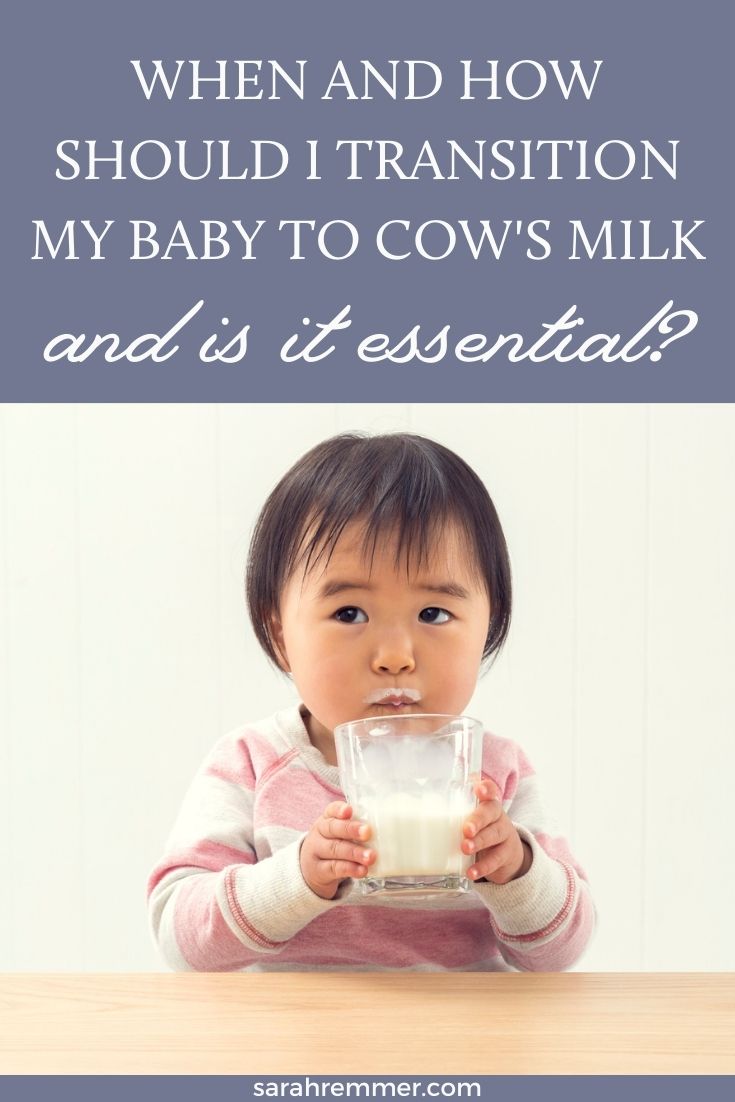Milk is a hot topic with parents and caregivers especially when a baby is transitioning away from breastmilk or formula. In this short guide I share helpful, well-researched information so that you can decide what’s best for babies and toddlers, and when. Included is information on milk alternatives, and at what age to offer almond, soy, rice or goat milks.

This post covers key questions from parents and caregivers, such as:
- What are the health benefits of cow’s milk for a child
- How and when to introduce cow’s milk if you’re breastfeeding
- How much milk should my child be consuming?
- When and how to offer your baby cow’s milk
- What about alternative milks for babies and toddlers
- What if my baby has a milk allergy or lactose intolerance
Need personalized nutrition support?
Book an appointment with one of our pediatric dietitians today!
Oh milk…
If there was ever a food that caused so much confusion, raised so many questions and was such a source of disagreement, milk would be it! As if feeding toddlers wasn’t confusing enough! All three of my kids drink milk. Not much—around one cup a day (plus some yogurt and cheese). They probably get around two servings of milk or dairy foods per day on average—sometimes less, sometimes more—which helps them meet some of their daily nutrient requirements.
Is cow’s milk essential? No. But some of the nutrients in cow’s milk, such calcium, vitamin D and protein ARE essential.

What are the health benefits of cow’s milk for children?
Cow’s milk is certainly an easy way for your toddler or child to get all of those nutrients in one drink (that most kids enjoy!), but it’s not the only way to get those nutrients. So, if cow’s milk is not your thing, or if you choose not to serve it for whatever reason (maybe your family follows a vegan diet or your child has a milk allergy), that’s A-Okay.
If this is the case however, it’s important to pick complementary foods to replace milk, so that your toddler still gets enough protein, fat, calcium, vitamin D, and other nutrients that they need. Although dairy can be an excellent source of both protein and fat, there are many other non-dairy sources (think meat, fish, eggs, avocado, nuts, seeds, etc.).
When it comes to calcium, dairy foods like milk, yogurt and cheese are likely the easiest way to ensure your child (and you) meet your needs. If dairy isn’t part of your toddler’s diet, it can be a bit trickier to ensure they meet their daily requirements. If you’re concerned or feel that you’re unsure, you likely need individual one-on-one dietitian support to ensure you get it right.
To give you some context into your child’s calcium requirements:
| Age | Calcium Requirements (Dietary Reference Intakes) |
| 0-6 mo | 200 mg (met through breastmilk and/or formula) |
| 6-12 mo | 260 mg (met through breastmilk and/or formula) |
| 1-3 yrs | 700 mg (met through food/beverages) |
| 4-8 yrs | 1000 mg (met through food/beverages) |
And to give you an idea of calcium-rich food sources:
| Food source | Serving amount | mg of calcium per serving |
| milk | 250 mL (1 cup) | 291-322 mg |
| yogurt (plain) | 175 mL (3/4 cup) | 263-275 mg |
| cheese (hard–like cheddar) | 50 mg (1 1/2oz) | 252-366 mg |
| canned salmon | 75 g (2 1/2 oz) | 179-212 mg |
| tofu (prepared with calcium sulfate) | 150 g (3/4 cup) | 302-525 mg |
| soy beverage | 250 mL (1 cup) | 321-324 mg |
| almonds | 60 mL (1/4 cup) | 93 mg |
| beans | 175 mL (3/4 cup) | 93-141 mg |
| spinach, cooked | 125 mL (1/2 cup) | 129 mg |
For example, a 1-3 year-old who consumes dairy could meet their daily requirements with 1 cup of whole milk + 1 1/2 oz cheese and a small amount of canned salmon throughout the day.
It might take a little more creativity for a child who does not consume dairy — let’s say 1/4 cup almond butter, 1/2 cup tofu, some canned salmon and cooked spinach. And being that ages one to three tend to be “pickier years”, this can be a bit challenging (although, not impossible). If a child continues to be breastfed, they will receive some extra calcium this way. Sometimes health care providers suggest that a formula-fed child continue to consume formula into their second year if their are growth and development concerns (in which case this would top up their calcium too).
How and when to introduce cow’s milk if you’re breastfeeding
Take your time–don’t rush it! You want to give your little one time to adjust to the new proteins and other nutrients in cow’s milk. Some moms like to start with one or two tablespoons a day, served along with formula or expressed breastmilk, then slowly increase the amount of milk over a few weeks until you are serving pure milk.
Some moms like to breastfeed morning and night and serve cow’s milk after lunch. Then eventually they replace the morning feed with cow’s milk too. As mentioned above, I recommend only serving cow’s milk via open cup (not bottle), so if your baby is bottle-fed, this might be the perfect opportunity to wean off of the bottle.
There’s no exact pattern you need to follow. Just take it slow to give baby a chance to adjust. It might take them some time to adjust to the new flavour too, especially if your baby is breastfed. Milk isn’t as sweet as breastmilk, so this may throw them off at first. Give them time to adjust. You can transitioning to cows milk around 11 or 12 months (or a little bit earlier depending on your baby and schedule) and slowly increase this amount until fully transitioned, which typically takes time—anywhere from 2 to 6 weeks.

How much milk should my child be consuming?
According to the American Academy of Pediatrics and Health Canada, your one-year-old should be getting about 16 oz (2 cups) of whole cow’s milk per day (or equivalent to this). If they also eat cheese and yogurt, you can reduce the amount of milk they drink if you’d like (but it’s not necessary).
Refer back to the tables above for daily requirements of calcium and some dairy and non-dairy sources (and amounts). Because milk is so nutritious and is an easy way to keep little one’s full and satisfied, sometimes it can be relied on too much. This can easily create or perpetuate picky eating issues and displace other important nutrients (like iron), so I suggest to stick to a maximum of two cups of milk per day and serve alongside meals (rather than in between). And hey, if you don’t want to feed your child any dairy foods, again, that’s ok!
Dairy foods are not “must-haves,” (as you can see in the chart, there are many calcium-rich choices) but the nutrients in dairy foods—like calcium and vitamin D—are vital. Regardless of whether your child drinks milk or not, they should still be given a Vitamin D supplement of 400 IU’s per day (you can continue giving Vitamin D drops). It’s too challenging to ensure that your toddler meet their requirements through food alone.
When and how do I introduce cow’s milk to my child?
If you choose to feed your toddler whole cow’s milk, it can be safely introduced to replace breastmilk or formula at around 12 months of age (and no sooner than nine months).
Before this age, your baby’s digestive tract isn’t quite mature enough to handle large quantities of the nutrients in cow’s milk. A bit of milk in a recipe is fine, but you do not want to offer a cup of milk until about 12 months of age. I recommend serving milk in open cups (not sippies or bottles).
Be sure to stick with whole milk to start; you don’t want to feed your baby reduced-fat or fat-free milk until after the age of two because they need dietary fat found in milk for proper growth and development. Depending on where you live, this milk may be called whole, homo, homogenized, full-fat, or 3.25% milk fat.

What about plant-based milk alternatives (like almond milk) for babies and toddlers?
This is important: Milk alternatives such as rice, hemp, coconut, oat, cashew, or almond beverages don’t contain enough calories, protein, or fat to directly replace breastmilk, formula, or cow’s milk. Using these milk alternatives alone won’t provide proper nutrition for growth and development, especially before 12 months of age. In saying this, it’s totally fine to blend up a smoothie and add a bit of almond milk, or to stir some coconut milk in your toddler’s oatmeal. But these milk alternatives should not be used as a replacement for cow’s milk, breastmilk, or formula, because they are simply not nutritious enough.
Here’s what you need to know:
Beginning at 12 months, if you are no longer breast- or formula-feeding, your best options are:
- Whole cow’s milk: This milk contains the essential protein, dietary fat, vitamins, and minerals your baby needs. And don’t use skim or 2% milk—whole cow’s milk contains extra fat, which is important for growth and development.
- Goat’s milk: Goat’s milk is comparable to cow’s milk in its nutritional qualities. It has similar amounts of protein, calcium, and vitamin A. Choose one that’s whole-fat, pasteurized, and fortified with folic acid and vitamin D.
Soy milk may be appropriate under these circumstances:
Unsweetened soy milk has about the same amount of protein as cow’s milk, but not as much dietary fat, so it’s not the best option—although some dietitians recommend it as the best option for vegan babies and suggest adding more dietary fat to the toddler’s diet in other ways (with healthy oils, nuts, seeds, salmon, etc.).
Read labels of milk alternatives: almond, coconut, hemp, or rice beverages are often fortified with similar vitamins and minerals as cow’s milk, but they don’t contain nearly enough protein or dietary fat to be considered a safe or healthy alternative to whole cow’s milk for this age group.
Your child will not get enough of the nutrients they need if you simply swap any of these plant-based milks 1:1 with cow’s milk and make no additional changes to their diet. These plant-based milks are NOT the same as cow’s milk, as you can see in the chart below.


What if my baby has a milk allergy or lactose intolerance?
Surprise, surprise—there is some controversy in the nutrition world about certain milk alternatives for toddlers, and soy milk is at the top of the list. Some nutrition experts believe that since it’s lower in calories, fat, and protein when compared to cow’s milk, it’s not a suitable alternative. Others believe it’s okay because it’s the closest plant-based option (nutritionally speaking) to cow’s milk. If your child has other allergies, read more on introducing allergens to your baby.
In cases where cow’s milk is not an option (maybe your child has a milk allergy or is vegan), you can offer full-fat, fortified, “original” (not unsweetened) soy beverage instead of milk as long as there are no growth or development concerns. If there are concerns, your child will need to consume a high-fat/high-calorie diet, and soy milk will not suffice.

Some conventional soy products come from genetically modified soybeans and may contain traces of synthetic pesticides or fertilizers. If this is a concern to you, choose an organic soy beverage. Check your package carefully to ensure that the soy beverage is fortified with vitamins and minerals (such as calcium and vitamin D), which are added to mimic the nutrients found in cow’s milk.
Beyond the nutrient content, there’s another soy controversy you should know about. Soy contains antioxidants known as isoflavones, which may protect against certain diseases. That’s good news.
Isoflavones have a mild estrogen-like effect, and that’s where some people kinda freak out a little. Estrogen is a sex hormone that plays an important role in reproduction, so some people wonder if soy will make their daughter go through puberty too early or make their son grow man-boobs. These are legitimate questions!
The answer is mostly that we don’t know. Very few studies have been conducted that involve children and soy intake, and the few that do exist are very small or are funded by the soy industry (so you can guess the findings might be swayed).
At the end of the day, it’s your choice as a parent whether you want to offer soy milk as an alternative to cow’s milk, because there isn’t enough science to make a truly non-biased, evidence-based decision.
As long as there are no growth or development concerns, you can continue to breastfeed into the second year (or beyond!) as long as your baby is nursing throughout the day. Keep in mind that cow’s milk is a convenient source of calcium, protein, fats, vitamin D, etc., but it’s not required.
Absolutely! Some babies never drink milk. Babies need the nutrients in milk — calcium and protein — but these nutrients are also available from other sources.
Bottom line
That’s a lot of information, but I hope that it helped to answer some of your questions about milk and dairy for your toddler. If you’re concerned or overwhelmed, my team and I are here to help!
You might also be interested in reading about what and how much your toddler should be eating, and how to deal with common toddler picky eating issues!




![[AD] It’s Day 6 of my 15-Minute Supper Series and today we’re putting a delicious twist on a classic BLT to make it nourishing and meal-worthy 🤤
Make sure to comment “Spud” and I’ll send you my top dietitian tips for feeding your family on busy weeknights along with a huge list of meal ideas!
This pasta salad takes no time at all to throw together and has everything you need for a nourishing meal. I always make extra bacon for things like this, but if you don’t have any cooked bacon I find cooking it in the airfryer or stovetop the quickest 🥓
I find that this salad lasts 2-3 days in the fridge without getting too soggy. You can also add in fresh lettuce to crisp it up or add the dressing when you eat it.
I ordered all of my groceries from @spuddelivers, which always saves me time and effort and gives me peace of mind knowing that I’m using high-quality, local and sustainable ingredients. I love that they come straight to my door the day after ordering 🙌🏻
Let’s make it!
Ingredients:
* 10 slices bacon cooked and diced
* 12 ounces pasta cooked and cooled
* 1 cup homemade Ranch dressing
* 1 ½ cup baby tomatoes diced
* ½ avocado diced
* feta
* ⅓ cup red onion diced
* 1 cup romaine lettuce
* fresh parsley for garnish optional
Homemade ranch dressing:
* ¾ cup mayonnaise
* ½ cup sour cream or Greek yogurt
* ½ teaspoon dried chives
* ½ teaspoon dried parsley
* ½ teaspoon dried dill weed
* ¼ teaspoon garlic powder
* ¼ teaspoon onion powder
* Salt and pepper to taste
Make it:
1. Blend all Ranch dressing ingredients together in a small blender (or whisk by hand) and set aside.
2. In a large bowl assemble the pasta, tomatoes, avocado, cheese, red onion, lettuce and bacon.
3. Pour the dressing over and toss to combine.
4. Garnish with parsley and serve.
You are going to LOVE this meal-worthy salad, I promise!
Comment SPUD to receive my top dietitian-approved tips for feeding your family during the week, a long list of ideas, and a curated shopping list with all of the ingredients for this recipe + all of the other ideas that I share in this resource!
#sponsored #spuddelivers #15minutemeals #whatsfordinner #easymealideas #dietitianapproved](https://www.sarahremmer.com/wp-content/uploads/sb-instagram-feed-images/438745920_798281295514125_2547899647147267180_nfull.jpg)


Comments
Britt says
So, you don’t *have* to feed your baby milk if the nutrients are supplemented somewhere else in their diet, yet giving them a milk alternative is a no-go? Why is this? Thank you!!
Sarah Remmer, RD says
Thank you for stopping by, Britt! If you keep reading until the end, you’ll find the answer here: https://www.sarahremmer.com/milk-for-toddlers-when-to-transition-and-to-what/#alternative
Sue says
My son is growing barley and planning to feed his newborn the combination of barley, water, cows, milk, and corn syrup. I am very concerned. The nutrition is not there for a month old baby and may actually be deficient to the point of dangerous. They want to do what Ron Hubbard says, but I think this is very old information. What do you think? Thanks for any response.
Sarah Remmer, RD says
Hello Sue, thanks for reaching out. There is a lot to unpack here. I highly suggest you reach out to my team here: https://www.sarahremmer.com/book-an-appointment/
Cara says
My son just turned one and I’d like to continue breastfeeding and slowly introduce milk as we go along. The issue is he has to go back to daycare in a week. He drinks from a bottle (breastmilk) once a day, nurses the other times, and 360 cup (water) throughout the day. Any suggestions on how to keep providing breastmilk at daycare while slowly introducing milk at at this age? Thanks!
Sarah Remmer, RD says
Hi Cara, thanks for reaching out and taking the time to share your concerns. There is a lot to unpack with this one so I’d highly suggest booking an appointment with my team! https://www.sarahremmer.com/book-an-appointment/
Arianne Newman says
What about if you plan to breastfeed for the second year? Would you still introduce cows milk and when ?
Sarah Remmer says
Great question, Arianne! As long as there are no growth or development concerns, you can continue to breastfeed into the second year as long as your baby is nursing at least 3-4 times per day. Keep in mind that cow’s milk is really just a convenient source of calcium, protein, fats, vitamin D, etc. – it’s not required. I hope that helps answer your question.
Carols says
What about if your toddler (mine is currently 12.5 months old) is still nursing, but only twice a day? Then do I need to give cow’s milk or other dairy products to meet calcium/Vitamin D needs? (And if so, how much?) Thanks!
Sarah Remmer, RD says
Hi Carols! Thanks for reaching out. I’d recommend you get in touch with my team for more individualized support: https://www.sarahremmer.com/book-an-appointment/
Joe says
Hi Sarah my LO is 17 months old 32″ tall long and 30LBS. My wife and I were concerned with giving him too much milk at his age he is consuming 750-900ml/day average. Are we ok to continue this way or should we bring it down?
His diet staples are;
1 egg
1 tbs peanut butter
1 tsp honey
20g oats
+
random servings of veggie/fruit puree packs, and various other foods to top up his calories.
As far as I can tell the only worry we should have is lack of iron?
If so could this be mitigated by serving a small amount of chicken liver 2x per week?
Thanks,
Joe.
Sarah Remmer says
Hi Joe, thanks so very much for taking the time to reach out to me. You are not along in having these concerns. I really cannot offer medical advice without knowing the full history. I’d highly recommend you book a consultation with us (even just an initial consult), so our team can help you further. https://www.sarahremmer.com/book-an-appointment/
Marlene Murphy says
Hi, thank you for the informative guide.
Babe is 9 months living in a dairy free house. I plan to wean sometime after 12 months.
What is your opinion on Ripple pea milk? Or Else toddler formula (I don’t think it existed when this guide was published).
Thanks!
Sarah Remmer says
Hi Marlene, that’s an excellent question! Here are the recommendations for the type of milk for each age range: 6-9 months: Still no cow’s milk or alternatives yet but at this time baby should be starting to eat solids foods. 9-12 months: At this age you can feel free to substitute whole cow’s milk for breastmilk or formula BUT only if baby is regularly eating iron-rich foods at least two times a day. 12-24 months: Whole cow’s milk can be freely substituted for breastmilk or formula. Hold off on the other milk alternatives for now because it does not have enough fat. 24 months +: 2% milk, goat’s milk or unsweetened fortified soy beverage can be substituted for whole cow’s milk. Hold off on the other milk alternatives for now. Please do reach out if your baby has a dairy allergy or you are a vegan household. Our dietitian team would have tailored recommendations. You can contact us here: https://www.sarahremmer.com/contact/
Holly Friedrich says
My Daughter just turned a year on the 24th, this being said she still has about three 8 Oz bottles of formula a day. What would be the best way to wean her out of this habit. And what’s a realistic time line goal to have ? I’m not comfortable with the cold turkey method some suggested. Thanks !
Sarah Remmer says
Slow and steady would be my advice. It’s tough – I totally get it. I would suggest reaching out to my lead counselling dietitian Lesley at lesley@sarahremmer.com for some individual support. She can dive into your daughters current intake, your schedule, and help you set up some realistic goals for weaning to milk.
Abby Langer says
I love your practical and informative approach to this tricky topic, Sarah! Thanks for making it a little less overwhelming for new moms.
Kara Lydon says
Love this topic! Such great practical and helpful information for mothers.
jeanette says
This is an important topic. Thanks for shedding light on it!
Stacey Mattinson says
Great review! My daughter didn’t like milk until a few months ago but now she loves it. I have to be sure she doesn’t go too overboard!
Heidi Moretti says
Thanks Sarah! Such an important topic for new parents and you covered this topic so well.
Amy Gorin says
Though I don’t have kids myself, this is helpful info for my nieces and nephews :).
LINDSEY PINE says
Love the chart listing calcium rich foods!
Shannon Garcia says
Thanks for posting this! There’s a lot of information out there on the topic and this was really helpful.
Kelly R Jones says
Good post! I JUST had someone reach out to me about this exact question for their one year old and since I don’t specialize in pediatrics, didn’t think my personal experience was enough. Sending it over to her!
Kate says
Should you switch to 2% after age 2? If yes, why?
Sarah Remmer says
You can make the switch to your milk of choice once your toddler reaches the age of two. Or you can continue with homogenized milk if that is the preferred milk in your household! It’s not necessary to switch milk once your child reaches two, but it is important to offer full-fat cows milk (for the protein, calcium, and vitamins) prior to reaching two. This is because of an increased demand for calcium, fat, and protein for little ones. Once kids reach two-years their eating is more established and their nutritional need is not as high. Hope this helps!
Tamara says
Now you can find full fat lactose free milk and cheese in most markets, so take advantage of that if your child is lactose intolerant. The milk contains the same nutrients as regular milk, minus the lactose and it tastes pretty much the same as regular milk.
Katelyn Kraayenbrink says
Do you need to introduce cows milk if you are still breast feeding? At 12 months I’m still nursing on demand but she does not eat a lot at Mealtime. I’m really struggling.
Sarah Remmer says
Thanks for reaching out! You do not need to introduce cows milk, especially if you’re breastfeeding. I’d love to hear more regarding your concern over your daughters eating at mealtimes. I do have a counselling practice called The Centre for Family Nutrition. If you’d like to sit down with my lead counselling dietitian please email Kathryn at kathryn@sarahremmer.com. We are here to help 🙂
Dr Liza says
I like Peaceful Planet organic rice toddler formula – hypoallergenic and complete nutrition!
Sarah Remmer says
Hi Liza! I haven’t yet heard of that one… I will have to check it out! Do you know if it’s available in Canada? What source of protein does it contain?